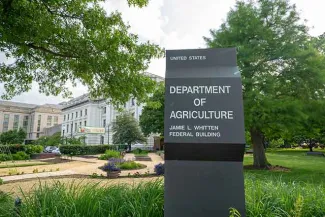
U.S. House panel debates boost for WIC in Agriculture funding bill
(Colorado Newsline) A U.S. House appropriations panel reviewed the Biden administration’s request to increase the U.S. Department of Agriculture’s budget for fiscal 2025 Thursday, with Republicans asking pointed questions about a proposal to boost a popular low-income nutrition program.
The hearing came less than two weeks after Congress passed a months-delayed appropriations bill for the USDA for the current fiscal year. Lawmakers have yet to finish a multi-year farm bill that is also delayed.

© iStock - Melissa Kopka
Agriculture Secretary Tom Vilsack advocated for Congress to pass the farm bill – legislation to authorize federal farm and nutrition programs – this year, and highlighted the ways the department is working to prevent funding shortfalls for critical programs for low-income families.
“We create a meaningful economic opportunity in rural America by improving critical infrastructure, supporting a clean energy economy and investing in a higher quality of life for those who live, work, play and raise their families in rural America,” Vilsack said in his opening statement.
Republicans on the panel took issue with the $25.1 billion budget request, an increase of $2.2 billion from the recently enacted fiscal 2024 law.
Backfilling WIC
The budget requests a total of $7.73 billion for the Special Supplemental Nutrition Program for Women, Infants and Children, or WIC. That number is $700 million above the recently enacted fiscal 2024 levels.
Subcommittee Chair Andy Harris of Maryland grilled Vilsack on the reason for the larger request for fiscal 2025.
Vilsack said the increase is needed because Congress took so long to pass fiscal 2024 funding, and only provided USDA with flat funding levels in short-term continuing resolutions, the agency had to transfer resources from other nutrition programs to avoid a $1 billion shortfall for WIC.

© iStock - TanyaLovus
“Part of the reason why we have the request that we have is to refill those transfers,” Vilsack said.
WIC provides nutrition assistance to about 6.7 million infants, young children and pregnant and postpartum patients per month.
“There is a limited amount of resources for all of the programs funded by this bill,” Harris said. “I think it is reasonable, and quite frankly it is our job as appropriators, to ask questions about the estimates for all of the programs, including WIC.”
Democrats on the panel defended the increase to WIC, and advocated for protections to the Supplemental Nutrition Assistance Program, or SNAP, which is authorized by the farm bill.
The top Democrat on the panel, Rep. Sanford Bishop of Georgia, said that the budget reflects a “growing demand for WIC funding as participation continues to rise.”
“We must rise to meet this critical funding need,” Bishop said of the WIC program.
The top Democrat on the full House Appropriations Committee, Rep. Rosa DeLauro of Connecticut, said she was intrigued by USDA’s proposal to backstop WIC funding, “so we do not face (a) nutrition assistance cliffhanger like we just went through.”
Crawfish, oranges and shrimp
Some lawmakers did not question Vilsack about USDA’s budget request, but instead asked him specific questions about agriculture-related crises in their districts and whether the department could help them.
Louisiana GOP Rep. Julia Letlow said a major drought has put the “crawfish industry on life support.” She said the crawfish are a more-than-$300 million commodity in her state, and she asked Vilsack if USDA could provide economic assistance to affected producers.
Vilsack said that he was happy to work with her and would have to check that the department has that discretion.
Democratic Rep. Debbie Wasserman Schultz of Florida asked Vilsack about an update on the USDA’s research on citrus greening, which is one of the most severe citrus diseases. She said Florida citrus growers have been struggling with the crop loss due to the disease.
“The problem is the cost of it is fairly significant,” Vilsack said. “I think that’s the next hurdle, is how do we get the cost down so that it’s available to producers.”
Alabama GOP Rep. Jerry Carl asked Vislack about adding domestic shrimp to a USDA list of foods to be used in school lunches in order to create “a sustainable path forward” for the industry.
USDA allows schools to use USDA Foods entitlement dollars to buy domestically grown food through an approved list.
Vilsack said that USDA would have to first see if there is a demand and availability for domestic shrimp and if it’s “something that school districts can afford.”
Iowa GOP Rep. Ashley Hinson said she was concerned with foreign entities – mainly China – buying U.S. farmland and the reliance on foreign entities for supplies relating to agriculture.
Congressional support for limiting foreign entities’ and individuals’ access to U.S. agricultural land has grown in recent years, with a focus on China. USDA records have shown that China owns fewer than 1% of U.S. farmland.
Vilsack said that USDA is updating its handbooks and process for how it collects data on land purchases and loans “to make sure we are doing the best job we can of identifying circumstances where land transactions occur.”
He added that there will always be challenges to that tracking system because there are more than 3,000 county offices across the country and tracking those purchases would require USDA to have a centralized database.
Vilsack also said that USDA is investing in fertilizer, because the U.S. was “over-reliant on Russia, Belarus, so we have to look at ways where we can be more self-reliant.”
He also noted that in Iowa, where Vilsack was governor from 1999 to 2007, China is the top purchaser of soybeans.
“So it’s a delicate conversation that we have with our No. 1 customer, at the same time, somebody who we’re deeply concerned about,” Vilsack said.
Colorado Newsline is part of States Newsroom, a nonprofit news network supported by grants and a coalition of donors as a 501c(3) public charity. Colorado Newsline maintains editorial independence. Contact Editor Quentin Young for questions: info@coloradonewsline.com. Follow Colorado Newsline on Facebook and Twitter.














